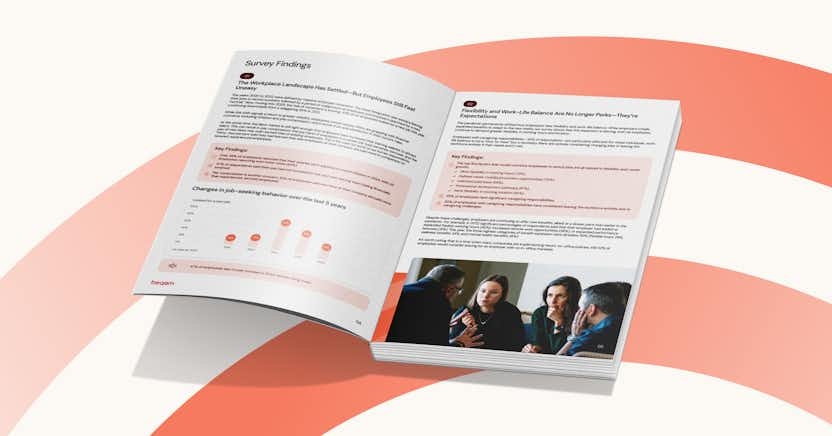A Nobel Prize and a Path to Pay Equity

Over the past four decades, the groundbreaking work of Claudia Goldin has opened our eyes to the realities and drivers of gender pay inequity. This month she was awarded the 2023 Nobel Prize in Economics, the highest achievement in the field. She is only the third woman to receive the prize, and the first to not share the award with male colleagues.
As we celebrate the well-deserved recognition of this pay equity pioneer, it’s worth considering: what do we do now? Understanding and managing pay equity in a large enterprise is not a simple matter. What can HR practitioners realistically do to ensure fair pay in their organizations?
The surprising drivers of the gender pay gap
Claudia Goldin opened our eyes to the gender pay gap by providing, as the Nobel committee put it, “the first comprehensive account of women’s earnings and labour market participation through the centuries” which revealed “the causes of change, as well as the main sources of the remaining gender gap”.
Prior to Goldin’s research, the difference in earnings between men and women was often attributed to education level and occupation choices. But her research pointed to something different. As the Nobel committee said, “Goldin has shown that the bulk of the current earnings gap is now between men and women in the same jobs — and that it mostly emerges after the birth of a woman’s first child.”
Today we tend to blame pay inequity on conscious or unconscious bias against women. Yet Golden looked at the pay gap issue from a larger societal perspective. Her landmark 1990 book, Understanding the Gender Gap: An Economic History of American Women, examined how wage inequality developed over the course of the preceding 250 years. She concluded that the defining difference-maker in women’s wages in the modern era was among heterosexual couples when they first had a child. That child has traditionally impacted the woman more than the man, because it is women who most often take on the unpaid caregiving and household labor.
Goldin’s analysis says the pay gap arises not because men and women are paid differently for the same work, but because the labor market incentivizes them to work differently, such as prioritizing flexibility in scheduling over high-demand jobs and maximum earnings. The market pays a higher rate to the person who is less constrained by family or domestic responsibilities.
“Claudia Goldin’s discoveries have vast societal implications,” said Randi Hjalmarsson, a member of the economic prize committee. “By finally understanding the problem and calling it by the right name, we will be able to pave a better route forward.”
Not that she ignored the issue of outright gender bias. Her 2000 research paper, Orchestrating Impartiality, found that after orchestras began to audition candidates behind a screen to conceal their identity, women musicians became 50 percent more likely to advance to later audition rounds, and were more likely to be hired in the final round.
But the question before us today as HR practitioners is, now that we are well aware of the gender pay gap, what can we do to ensure equal pay for equal work in our organizations? What are the challenges we face and what tools do we have to make pay equity a reality?
Why is pay equity so challenging in large organizations?
Large organizations account for a significant proportion of the overall workforce, and so can have a major impact on helping to close the gender pay gap and other pay inequities. However, their size and complexity pose special challenges, especially in global companies.
Even when intentions are good, ensuring equal pay for equal work can be challenging In large organizations, for a variety of reasons:
Complex job structures: Large organizations often have intricate job hierarchies with a wide range of roles, responsibilities, and job titles. Identifying what constitutes "equal work" can be challenging due to these complexities.
Pay history and negotiation: Pay disparities can arise from historical compensation practices and individual salary negotiation. If certain employees negotiated higher salaries in the past or were hired at different times, it can lead to pay disparities that are hard to rectify.
Unconscious bias: Unconscious bias can play a significant role in pay disparities. Managers and HR professionals may unconsciously favor or disfavor certain groups, which can result in unequal pay for equally qualified employees.
Lack of pay transparency: In many organizations, pay information is not transparent, making it difficult for employees to compare their compensation with their colleagues. Without transparency, it's hard to identify and address wage gaps.
Pay equity analysis: Conducting a thorough pay equity analysis in a large organization can be resource-intensive. Analyzing salary data for all employees, accounting for various factors that influence pay, and ensuring that disparities are not due to gender, race, or other protected characteristics can be complex.
Legal and regulatory challenges: Organizations must comply with a myriad of employment laws and regulations related to pay equity, which can vary by jurisdiction. Navigating these legal complexities while striving for pay equality can be demanding.
Resistance to change: In some cases, there may be resistance within the organization to address pay disparities, particularly if it requires making adjustments to certain employees' compensation packages.
Data quality and availability: Ensuring that the data used to assess pay equity is accurate and comprehensive can be a challenge. Data discrepancies or limitations can hinder efforts to identify and rectify pay disparities.
Industry norms: In some industries, there may be established norms or practices that perpetuate pay gaps, such as historically underpaying certain job categories.
Compensation philosophy: An organization's compensation philosophy and strategy can influence pay disparities. If the philosophy is not aligned with principles of pay equity, achieving equal pay can be more difficult.
Organizational size and complexity: The larger an organization is, the more challenging it can be to implement consistent pay practices across all departments, subsidiaries, and regions, especially if there is limited centralized control and/or global complexities.
Addressing these challenges requires a comprehensive approach, including clear pay equity policies, data analysis, pay transparency, ongoing monitoring, cultural changes within the organization, and having the necessary enabling systems.
How can compensation and performance systems support pay equity?
Compensation and performance management software can play a significant role in enabling pay equity by facilitating fair and transparent compensation practices and supporting the growth and career development of all employees equally. Here's how these two types of software can contribute to achieving pay equity in an organization.
Compensation Management Software
Using a compensation management solution that is designed for the scale and complexity of large organizations can help make pay equity a reality by providing the following:
Pay structure management: Compensation management software allows organizations to design and manage total compensation, including structures for salary, bonus, and long term incentives, with internal and external benchmarking. This can help ensure that compensation levels are consistent and fair for similar roles.
Pay equity analysis: Compensation management tools that have built-in pay equity analysis features can help organizations analyze compensation data to identify disparities based on factors like gender, race, or other protected characteristics.
Merit-based compensation: Tools that are rules-driven can assist in implementing merit-based compensation strategies, where pay increases are tied to employee performance and contributions. This approach supports fairness and transparency.
Predictive modeling: Some compensation management software offers AI-based predictive modeling features, allowing organizations to make data-driven pay decisions, assess the impact of compensation decisions, and make adjustments to ensure equity.
Pay transparency: Compensation management software can provide transparency by allowing employees to view their compensation and understand how it's determined. Transparency can help address concerns related to pay secrecy and potential discrimination, and is a key capability for fair pay regulatory compliance.
Audit trails: Centralized compensation software can maintain audit trails that record compensation decisions, approvals, and changes, ensuring that decisions are made and documented in a consistent, compliant, and non-discriminatory manner.
Automated alerts: Automated alerts can notify HR and management when pay disparities are detected or when pay decisions deviate from established policies, enabling timely correction.
Performance Management Software
A performance management solution that supports a culture of accountability, fairness, growth, and performance, can play an important role in ensuring equality by providing:
Goal alignment: Aligning individual goals with organizational objectives can promote a fair and equitable performance evaluation process, ensuring that compensation is linked to contributions toward common goals. Ensuring all employees’ goals are aligned with organizational objectives helps to promote fairness in career development.
Feedback and development: Research has shown that women often do not get the same level of feedback as men, hampering their ability to grow and develop. The right performance management tools can enable both managers and peers to provide constructive feedback and support employees' professional development, helping to address potential performance gaps that may affect compensation.
Objective evaluations: Performance management software allows organizations to establish standardized and transparent performance evaluation criteria and metrics. By focusing on objective, job-related factors, it reduces the potential for bias in performance assessments.
Real-time performance reviews: Performance software can support managers in conducting regular check-ins and performance reviews, to ensure that employees know what they need to do to grow and advance, and that they are assessed and documented consistently across the organization.
What policies and procedures should we have in place?
To maximize the potential of performance management and compensation management software in achieving pay equity, organizations should:
Define clear compensation policies: Implement well-defined compensation policies and guidelines that emphasize fairness, transparency, and equal pay for equal work.
Regularly monitor and analyze data: Use these software tools to regularly monitor compensation data for disparities related to gender, race, or other protected characteristics. Perform pay equity analyses to identify and address potential gaps.
Educate and train personnel: Ensure that HR professionals and managers are trained in using the software effectively and are educated about the importance of pay equity and non-discrimination in compensation practices.
Communicate policies and transparency: Clearly communicate compensation policies and the organization's commitment to pay equity to employees. Use the software to provide transparency regarding compensation decisions, and visibility into compensation plans and calculations.
Stay compliant with regulations: Ensure that the software helps in complying with relevant employment laws and regulations related to pay transparency and equity.
Making pay equity a reality
By combining performance management software and compensation management software with a commitment to fairness and transparency, organizations can work towards achieving pay equity and promoting a more inclusive and equitable workplace.
The fact that we are even looking at pay equity can be directly traced to the work of Claudia Goldin. We celebrate her richly-deserved Nobel Prize, even as we work with today’s HR and managers to help make equal pay a reality in organizations worldwide.
Implementing pay equity requires a strategy that will work for your organization. To get started, check out our Pay Equity Playbook: A Strategic Approach to HR.
















